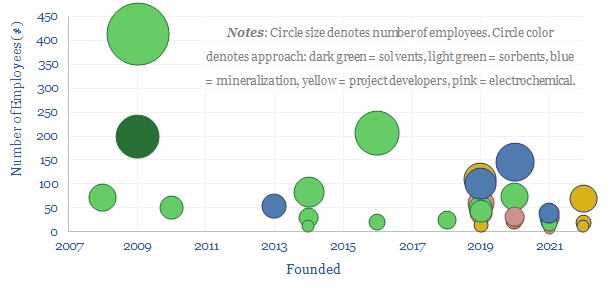DAC to the future?

…of L-DAC are reviewed on page 6. Solid DAC (S-DAC) uses sorbents to react with ambient CO2. Advantages and challenges of S-DAC are reviewed on page 7. Next-generation sorbents are…

…of L-DAC are reviewed on page 6. Solid DAC (S-DAC) uses sorbents to react with ambient CO2. Advantages and challenges of S-DAC are reviewed on page 7. Next-generation sorbents are…

…designs. It is not an L-DAC design, nor an S-DAC design, nor an E-DAC design, but an oxy-fired combustion design. Schematic for oxy-fuelled calcining DAC DAC costs of $200-300/ton may…

…rapidly, trebling in the past half-decade, especially towards novel DAC solutions. $559.00 – Purchase Checkout Added to cart Most of the DAC companies in this data-file are private, with an average of…

…selectively adsorb CO2 when a voltage is applied, then desorb them when a reverse voltage is applied, unlocking 70% lower energy penalties than incumbent L-DAC and S-DAC? $499.00 – Purchase Checkout Added…

…and philosophy of nature-based solutions for sequestering atmospheric CO2. Although next-generation DAC companies may provide an increasingly interesting complement. Although it is fascinating to consider that next-generation DAC could ultimately…

…DAC. Some buyers may be willing to pay a premium for DAC CO2 removal credits over reforestation removal credits due to higher perceived quality, especially around the dimension of CO2…

…value chains (more below). https://thundersaidenergy.com/downloads/hydrogen-overview-and-conclusions/ Conclusion #5: still looking for magic bullets in CCS and DAC? If you are starting from a baseline of air, with 400ppm CO2 concentration (i.e.,…

…say, Carbon Engineering. The main innovation visible in Climeworks’ patents is a DAC plant with optimized air flow, passing CO2 through layers of fabric housing CO2-adsorbing materials. This is an…

…place next on the cost curve and could each have GTpa scale. Power stations place next, at $60-100/ton. DAC is conceptually attractive, as the only carbon negative technology, but if…

…by 3-5x (note here). But we think AI can likely double the utilization rates of grid infrastructure (pages 13-14). How will AI reshape CCS and DAC value chains? The thermodynamic…